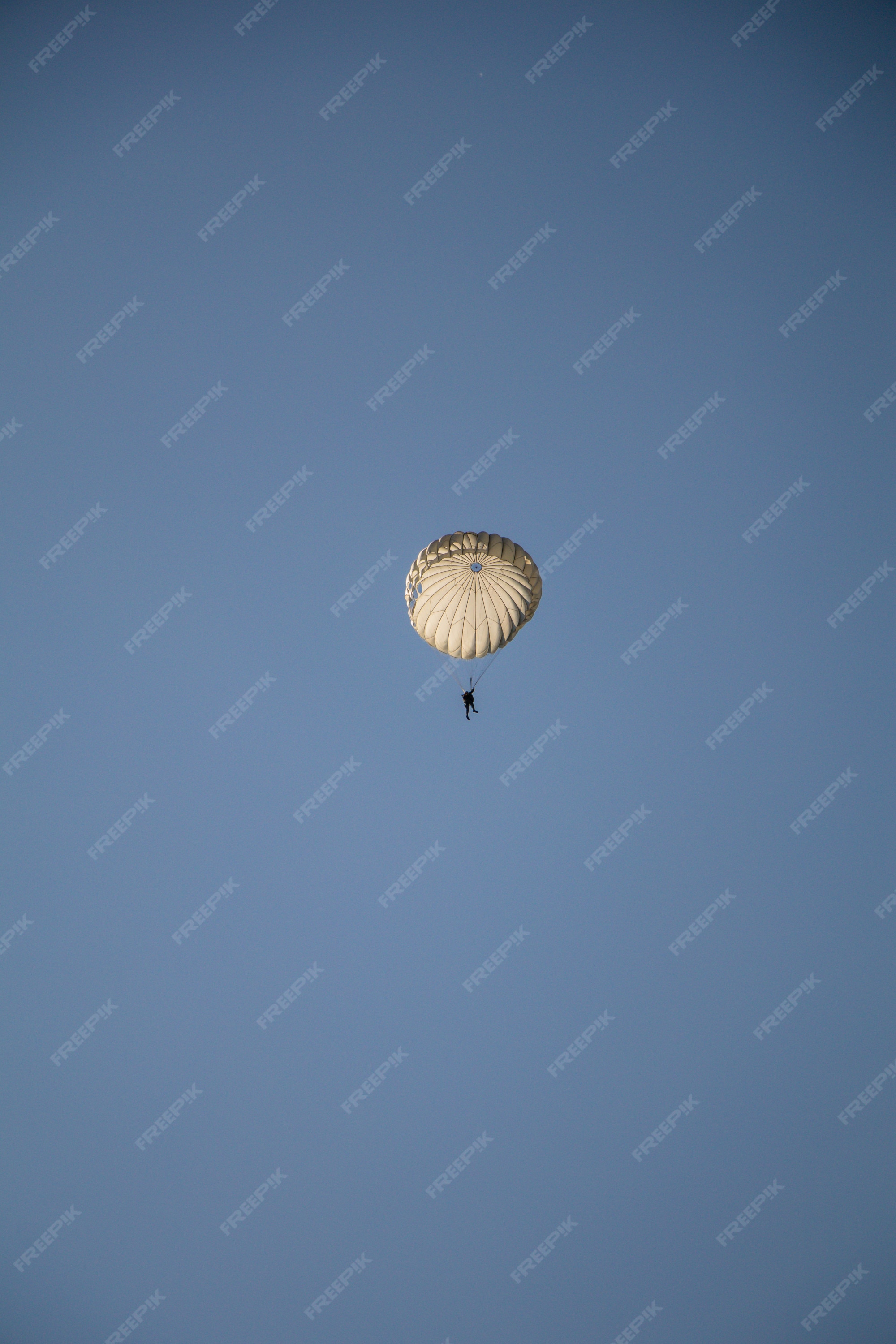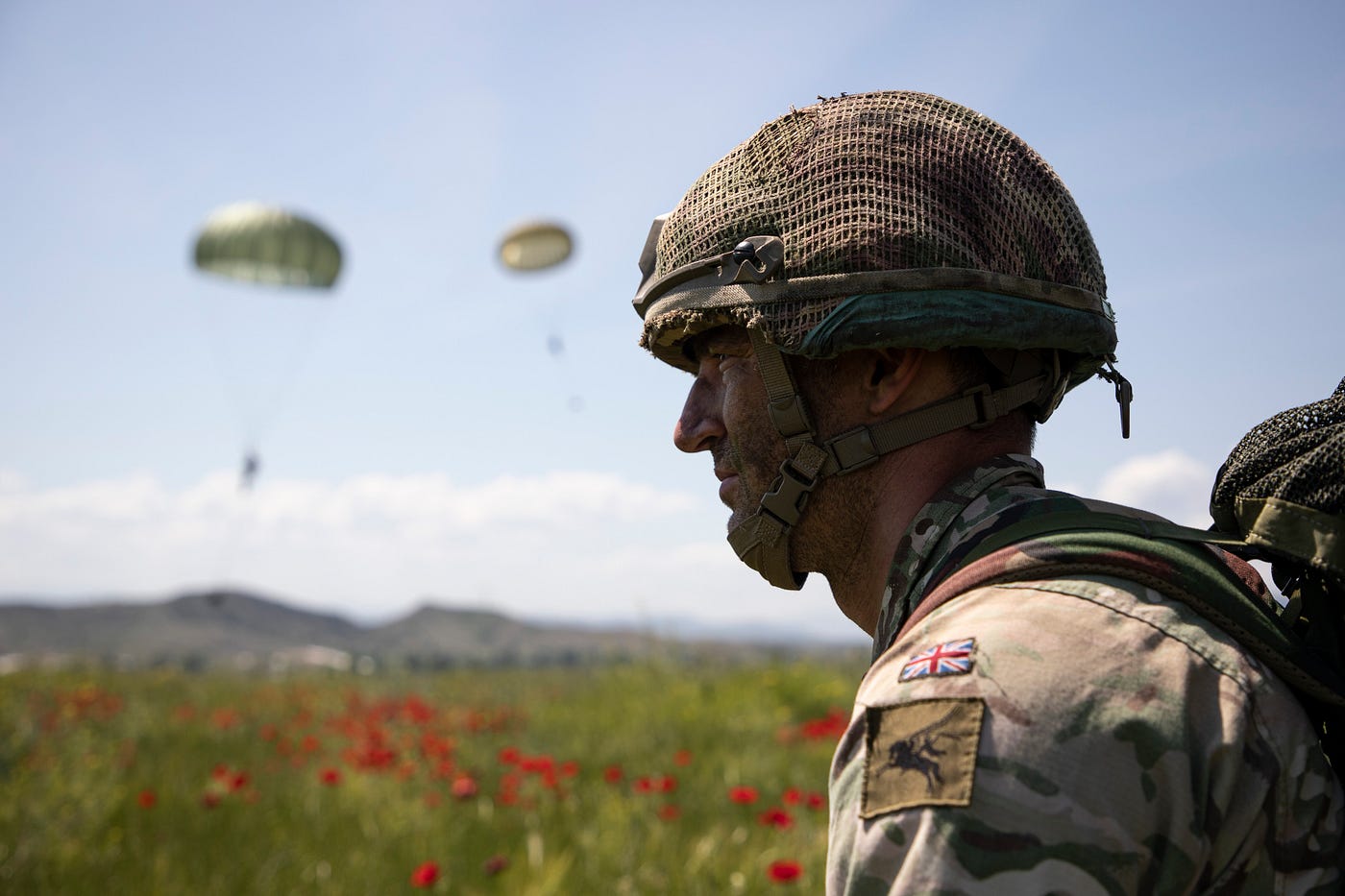Military Parachute - The Static Canopy (T-11) Personnel Parachute System is a new personnel parachute system used by the United States Army and the Canadian Army.
The T-11 replaced the T-10, which was introduced in 1955. The T-11 includes completely redesigned main and reserve parachutes and an integrated armor set better suited to heavier troop weights than the previous system.
Military Parachute

The main curtain is a modified version of the cross/cruciform platform. 14 percent larger roof diameter and 28 percent more surface area than the T-10D assembly. The T-11's main curtain uses a special Diplomat sequence to reduce opening shock and cell wave. The T-11 was designed for a 95th Air Force average speed of 19 feet per second (5.8 m/s), compared to the T-10C's 24 feet per second (7.3 m/s). This reduction is intended to significantly reduce the incidence of landing injuries for jumpers.
Paratroopers Descend To The Drop Zone
The reserve canopy is derived from the British Low Level Parachute (LLP) aero-centric design and includes high scoop pockets at the top of the reserve canopy and skirt support lines at the top of the system to encourage quick opening of the reserve system at low altitudes. . Speed bumps. Unlike the Kurt Reserve parachute system, the T-11R Reserve uses an omnidirectional, cter-pull deploy system. The T-11 harness is designed to evenly displace the initial shock force of the reserve parachute along the long axis of the jumper's body.
The main curtain and harness weigh 38 pounds (17 kg) and the backup set 15 pounds (6.8 kg) for a total of 53 pounds (24 kg). The main roof is 30.6 feet (9.3 m) in diameter from the top. The diameter of the reserved roof is 24 feet (7.3 m).
The T-11 parachute is used by the United States Armed Forces. A first in Europe, the Finnish Defense Forces are receiving.
During a test conducted by the US Army's Airborne and Special Operations Test Directorate, the 82nd Airborne Division's 2nd Brigade Special Forces Battalion performed the first mass tactical jump using T-11 parachutes.
Military Parachute Stock Photos, Royalty Free Military Parachute Images
This year on July 12, 2011, the United States Army temporarily suspended all T-11 parachutes following an accident at Fort Bragg, North Carolina. ECDIT investigators found problems with the packaging, inspection, quality control and performance of the T-11 parachute. Secretary of the Army John McHugh has ordered the suspension of use of the T-11 pending further investigation and necessary modifications.
Another fatality involving a T-11 parachute occurred on May 30, 2014, during a night jump at the Holland Drop Zone at Fort Bragg, North Carolina.
The investigation found that the jumpmaster failed to check the paratrooper's equipment before jumping in the accident, and the military made policy changes as a result.

On July 14, 2016, Sgt. Arturo Godinez Valzuela, 31, died when a Mexican Army T-11 paratrooper deployed his parachute during a training exercise with the 82nd Airborne Division at Fort Bragg. The cause of death was severe altitude sickness. The T-10 parachute is a series of fixed line-deployed parachutes used by the United States military for large-scale airborne operations and training. The T-10 parachute was introduced in the early 1950s. In 1976, the B model introduced an anti-reversal net; This year in 1986, the C model was introduced, which changed the free lgth of the pocket band from 4" to 7½". The T-10D, introduced in 2000, included a detachable roll tray, which itself had 15' of universal fixed line and 5 ' expansion includes a static line. The T-10D has been replaced by the T-11 parachute system. In 2006, all T-10C parachute packages were upgraded with the addition of a static line stow bar on each side. The -10C material is also mud resistant. Water 407 has changed
Army Paratrooper Vet Recalls Surviving A Jump With A Broken Parachute
Depending on the air density and the overall weight of the jumper, the parachute has an average descent rate of 22 to 24 feet per second (6.7 to 7.3 m/s). The total curb weight limit is 360 pounds (160 kg). The parachute is deployed using a 15 or 20 ft (4.6 or 6.1 m) fixed line, allowing the parachute to be delivered by a C-130 or C-17 aircraft. The T-10D's main parachute is parabolic-shaped and nominally 35 feet (11 m) in diameter with 30 suspension lines. The tire assembly weighs 31 pounds (14 kg). Paratroopers can descend 500 feet (150 m) from an aircraft at a maximum speed of 173 mph (150 kn). Maximum jump wind speed is 15 mph (13 kn).
The T-10D parachute assembly consists of five components: pack tray, troop harness, deployment bag, ramp, and canopy. The cumulative service life of the parachute is 16.5 years; The service life is 12 years and the shelf life is 4.5 years. The T-10D parachute must be deployed every 120 days. The T-10D parachute is made from the same nylon material commonly used to make parachutes.
The Improved Improved Reserve Parachute System (MIRPS) consists of a standard T-10 reserve parachute cantilever assembly, harness line, pilot parachute and spring integrated with commercial deployment aids. The package tray includes a line bag with suspension lines and an internal staging flap that holds the standby parachute until the brand/pilot runs out of the parachute assembly during deployment. The MIRPS roll tray is slightly larger than the T-10 standby roll tray so it can accommodate the larger pilot chute, spring and harness. The packing tray has a yellow strap over the tear cord protection flap and is made from a nylon fabric material commonly used to make parachutes.
The MC1-1B is a derivative using a similar parachute-like design. The base plate is the same as the T-10B assembly, except that 11 of the 30 grooves are slotted or cut, creating a sliding type disc. The roof has two control lines, each leading through an external hole to a switch that can be rotated 360°. It has a 3 3/4-inch mesh anti-reversal net that extends 18 inches below the curtain skirt. British, Italian and US military personnel during an exercise in Pordo, Italy, 2019.
Th Wmc Parachuting
A paratrooper is a military parachutist - a person trained to parachute in military operations and often serves as part of the Air Force. Army parachutists (army) and parachutes were used extensively during World War II for the delivery and transport of troops. Paratroopers are often used in surprise attacks to capture strategic objectives such as airfields or bridges.
A US Army parachute from a C-130 Hercules aircraft of the 82nd Airborne Division during Operation Toy Drop at Pope Air Force Base in 2007
Paratroopers jump from airplanes and use parachutes to land safely on the ground. This is one of the three strategic techniques of "trying to force" to construct a theater of war. The other two are land and water. The tactical advantage of cutting the battlefield from the air is to attack areas that cannot be directly reached by other transports. The ability of air strikes to reach the battlefield from anywhere allows paratroopers to bypass fortifications that resist attack in a specific direction. The availability of paratroopers forces the Guard to deploy to protect other areas that would otherwise be vulnerable. Another common use of paratroopers was to establish airfields for landing other units during the Battle of Crete.
The Italian offensive made the first operational military parachute jump from 1600 feet on the night of 8/9 August 1918. RDT Leutant Alessandro Tandura, flying a Savoia-Pomilio SP.4 of Grupo Specialized Aviazione, was shot down by Canadian Major William George Barker and British Captain William Wedgwood Bann (both Royal Air Force pilots). On a reconnaissance and sabotage mission behind the Austro-Hungarian lines near Vittorio Veto, then at night by Lieuts. Ferruccio Nicoloso and Pier Arrigo Barnaba.
Man Riding Parachute During Daytime, Customplay Golf Paratrooper Parachute Military Army, Parachute, Sports, Military Vehicle Png
The first paratroopers (Fallschirmjäger) were used by the Germans in World War II. Paratroopers were used extensively by the Allied forces in the later conflict. Modern cargo planes (such as the German Ju-52 and the American C-47) were small, so groups of more than 20 people rarely jumped from a single plane. In Gaelic this load of paratroopers is called a "dula", a load of troops mobilized for air movement is called a "nora". The term derives from the use of white chalk on the sides of aircraft and vehicles to denote and modernize personnel and armor.
Paratroopers often used spherical parachutes during World War II. It can be operated by pulling on the parachute risers (the four lugs that connect the parachute harness to the links) and the harness lines attached to the parachute canopy. Equipped with only a single ramp at the rear, German paratroopers could not deploy their parachutes in this manner. Paratroopers still exist today.
Military parachute cord, military cargo parachute, military parachute training, military parachute harness, military surplus parachute, military parachute backpack, military parachute pants, military parachute jump, military surplus parachute canopy, military parachute flares, used military parachute, military parachute for sale

0 Comments